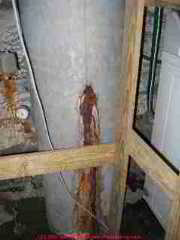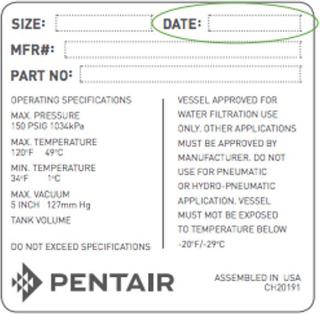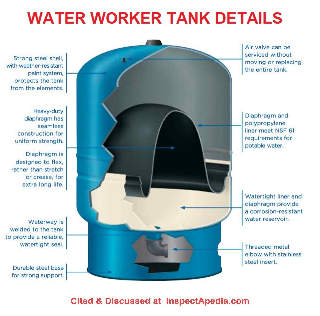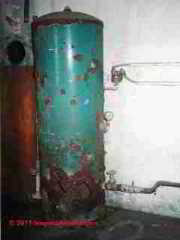 Water Pressure Tank Life Expectancy
Water Pressure Tank Life Expectancy
Water Tank
Replacement Guide & Age De-Coder
- POST a QUESTION or COMMENT about the typical life of a water pressure tank or water storage tank, and about when & how to replace a water tank
Water tank life, water tank replacement.
This article explains how long a water tank is expected to last (it varies) and we describe how to decide when a water tank needs to be replaced - advice about what to do when things go wrong, such as finding air and water leaks and the process of deciding to replace a water pressure or water storage tank.
We also discuss where to put the water tank in relation to the pump and pump control switch. And we provide a water tank age decder as well as a Table of water tank brands, warranties, warranty periods. Table of Water Storage Tank Materials, Life, Warranty Period. Steel Water Tank Rust Perforation. Where to Locate the Replacement Water Pressure Tank.
InspectAPedia tolerates no conflicts of interest. We have no relationship with advertisers, products, or services discussed at this website.
- Daniel Friedman, Publisher/Editor/Author - See WHO ARE WE?
When do you need a new water pressure tank?

How Long Does a Water Tank Last?
The life expectancy of a water storage tank or water pressure tank depends on at least these variables:
- The water tank material:
fiberglass, plastic, steel, galvanized steel, epoxy coated or glass coated tank liner. In order of probable life from shortest to longer we'd pose: unlined steel water tank, glass lined or epoxy-lined water storage tank, internal bladder type water tanks that store water inside the bladder, plastic or fiberglass water tanks. - The water tank type:
internal bladder holding water separate from air in the tank may have a longer life than a steel water tank - The water tank installation and maintenance:
a mistake like connecting galvanized iron fittings to copper fittings reduces tank life as can water tank installation location: in a flooding well pit, in a wet crawl space for example.
See details at GALVANIC SCALE & METAL CORROSION - The water chemistry:
aggressive water, more corrosive - note that this is a factor principally for water pressure tanks that do not use an internal bladder, keeping the water physically separate from the air charge. - Water temperature:
some warranties make clear that handling water temperatures over 180F can void the tank warranty[3] - The amount of water usage:
running more water through steel components may reduce their life - Regular maintenance and inspection:
to check for and repair minor leaks, assure proper operating pressures - Water tank environment:
installing a water tank in a wet crawl space or flooding well pit is surely going to reduce its life due to rust, freeze-risk, etc.
When an older type (non-captive-air) tank needs replacement (for example because it has rusted through and has perforations leaking water or air, or if adding air frequently becomes a hassle, you'll want the newer type of "captive air" or "bladder" tank.
If your tank looks like it has leprosy, if you see water streaming down its side from a "pinhole" leak, it may be possible to make a temporary emergency repair using a rubber washer and screw.
Your hardware store sells special screws for this purpose. This is only a stopgap measure. You need a new tank.
Various types of tanks uses in and around buildings are identified and explained below, including water pressure tanks, water storage tanks, range boilers for hot water, indirect fired hot water tanks, expansion tanks in attics, basements, and on heating boilers, oil storage tanks, rooftop tanks, cisterns, water pressure booster systems. We also discuss when to replace water tanks.
Table of Water Storage Tank Materials, Life, Warranty Period
[in process, suggestions welcome]
Water Pressure Tank Life & Warranty Comparison Summary by Manufacturer & Tank Type |
||
| Water Tank Type | Rated Life or Warranty | Comments |
| Amtrol, Well-X-Trol internal bladder, pre-pressurized | Warranty: 7 years | Product range, multiple sizes [7] |
| AquaTanks, polyethylene | Warranty: 25 years | New Zealand, export, stackable tanks, 295L to 31,000L, above ground & underground, various colours [9] |
| Flexcon Well-Rite, Challenger (butyl internal bladder), FlexLite, Flow-Thru, Jet Rite, FLEX 2 PRO and InWell brands | Warranty: 5 years | U.S., Canada, Mexico [10] |
| Flotec 35-Gallon internal bladder | Warranty: 5 years | # FP7120 |
| Lochinvar glass lined water storage tanks | Warranty: 5 years | Thse [3] |
| Norwesco plastic aboveground water storage tanks | Warranty: 3 years | From date of manufacture. These tanks are used for chemical storage, not solely for water. Tank life when used for water storage may differ than when storing other chemicals. For water, these tanks meet FDA specifications for storage of potable water [2] |
| PVI® Storage Tanks (water heaters), glass lined | Warranty: 5-20 years | AquaPLEX® engineered duplex alloy, standard tank warranty is 10 years with a 20-year option. NICKELSHIELD® nickel-plated tank, standard tank warranty is 10 years with a 20-year option. POLYSHIELD® polymer-lined tank, standard tank warranty is 5 years with a 15-year option.[4] |
| Underground plastic water tanks, polyethylene tanks, using some polypropylene or EPDM components | Warranty often extends from date of manufacture, not installation | Selected and installed per instructions does not void warranty for this tank type. Installing under a driveway voids warranty. |
| Utilitech 86-Gallon vertical, bladder, interior coated | Warranty: 5 years | # LPT-86 Same for smaller models |
| Water Worker 14GAL Horiz Pressure Tank | Warranty: 5 years | #HT-14HB (Sears) |
| Wellmate Composite Water Tanks, by Pentair, internal bladder, Residential application | Warranty: 5 years from installation | No steel components. [5] |
Notes to the table above
Watch out: in collecting water tank warranty and life expectancy data we found that the variety of tank types and tank uses produces a wide range of data. When comparing tank life expectancy or warranty be sure you are comparing tanks intended for the same application
In our experience internal bladder water pressure tanks last well beyond their warranty period. An OPINION guess woudl be 10-20 years is average for these systems.[1]
In our experience galvanized steel water pressure tanks, nearly all of which contain some sort of internal coatings, last beyond their warranty period. We've seen tanks fail in five years (aggressive water, new modern thinwalled tank, possiblyi with a defective internal coating, and we've seen older, thick-walled, well-coated galvanized steel water pressure tanks last 25 years or longer.
We do not have long term experience with fiberglass or plastic type water storage tanks but in our OPINION expect their life to be 20-25 years or more if protected from UV (for some plastics) and from mechanical damage.
Also see WATER TANK AGE DECODER
Steel Water Tank Rust Perforation & Emergency Tank Repairs
This steel water storage tank is leaking. When you see damage like this on a water tank, the perforation has rusted through from inside the tank. A tank that looks like this needs to be replaced.
Watch out: don't poke at rust like this on a water tank - you are likely to change a slow seep or drip into an immediate catastrophe - the steel around the site of rust perforation is usually quite thin. You still need to replace the water tank but this approach can stop or slow a leak while you wait for the new tank to be installed.
If the rust perforation on a steel, bladderless water pressure tank is very tiny, 1/8" or so, temporary repair can sometimes be made using a special short lag-type threaded screw with a neoprene washer.
Leak repair screws are sold for this use.
Details of this rusted leaky water tank leak repair procedure are
at WATER TANK PERFORATION LEAK REPAIR
Where to Locate the Water Pressure Tank
This topic moved to its own page at WATER TANK LOCATION GUIDE
Water Storage Tank / Cistern Life
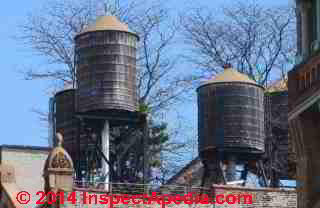 Reader Question: expected life of rainwater harvesting tanks
Reader Question: expected life of rainwater harvesting tanks
Unless there are some special effects of the use of a storage tank for harvesting rainwater, I think the tank life will depend on the factors I list below: in short, the tank materials, application, environment, and external influences on it.
I trust the manufacturer to know the minimum life of their product and to reflect that in their warranty, though that's not always the case (see water heater warranties).
- Concrete cisterns or concrete and stone cisterns for water storage can have a life of more than 100 years yet may fail quickly if the concrete mix is poor or from cracking or settlement.
See CISTERNS, WATER STORAGE - Fiberglass rooftop water storage tanks, even exposed to the sun in sunny climates (Mexico where my experience derives) regularly serve 15-20 years or more.
- Plastic water storage tanks (such as polyethylene tanks) are warranted, you note in the article above, from 5-7 years in most cases with an occasional 25 year warranty.
See PLASTIC RECYCLING CODES, TANKS, TYPES - Steel water storage tank life varies widely by steel quality, gauge, coating, and exposure to water chemistry as well as by the effects of water usage volume which in turn may effect the life of steel materials similarly but probably less significantly than the scouring effects of water flow rate and volume through metal water piping systems.
- Wooden water tank life: In the U.S. wooden water storage tanks have been in use for more than 150 years.
New York City rooftop water tanks made of wood are expected to last 20-25 years but some have endured well over 50 years, a few much longer. Maintenance has been cited as making as much as a 30% difference in the life of rooftop water tanks. (Johnson 1998).
See ROOFTOP WATER TANKS
If I were concerned for water storage tank life I'd be at least as interested in the factors that affect tank life as I would in the tank material. Sun exposure, exposure to mechanical damage, water chemistry, in some cases water volume use installation details.
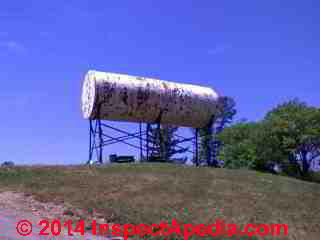 Here is some scholarly research reporting on water tank life in particular applications:
Here is some scholarly research reporting on water tank life in particular applications:
- Ardente, Fulvio, Giorgio Beccali, Maurizio Cellura, and Valerio Lo Brano. "Life cycle assessment of a solar thermal collector." Renewable Energy 30, no. 7 (2005): 1031-1054.
- Bakelli, Yahia, Amar Hadj Arab, and Boubekeur Azoui. "Optimal sizing of photovoltaic pumping system with water tank storage using LPSP concept." Solar Energy 85, no. 2 (2011): 288-294.
- Johnson, Eric, "Rooftop Water Tanks, Proper Maintenance is Essential", The Cooperator, Dec/Jan 1998, retrieved 30 Jul 2015, original source: http://cooperator.com/article/rooftop-water-tanks
Excerpt:
David Hochauser, president of Manhattan-based Isseks Brothers, a water tank manufacturing, installation and maintenance company that has been in business for generations, agrees with this assessment.
He says, Wood water tanks are an effective means of delivering clean and sanitary water to a building. And the water tastes good. However, the tank will not do its job, and it will not last, if it is not maintained.
An exposed wood tank should last about 20 to 25 years, but it will last even longer if it was well-constructed, if it was properly installed, and, most important of all, if it undergoes routine maintenance. Hochauser points out that, with proper care, the life expectancy of a wood tank can be increased by as much as 30 percent. - The MACRS Asset Life table is derived from Revenue Procedure 87-56 1987-2 CB 674 does not appear to include an asset life for rainwater harvesting tanks nor other water storage systems. - See http://www.irs.gov/Businesses/Cost-Segregation-ATG-Chapter-6-3-Depreciation-Overview
- Rivera, Frank, Frank G. Runyeon, Russ Buettner, "Inside City's Water Tanks, Layers of Neglect", The New York Times, 27 Jan. 2014, original source: http://www.nytimes.com/2014/01/27/nyregion/inside-citys-water-tanks-layers-of-neglect.html
- Kalogirou, Soteris. "Thermal performance, economic and environmental life cycle analysis of thermosiphon solar water heaters." Solar Energy 83, no. 1 (2009): 39-48.
- Takeuchi, Hikaru, Sachiro Taketomi, Shinya Samukawa, and Antonio Nanni. "Renovation of concrete water tank in Chiba Prefecture, Japan." Practice Periodical on Structural Design and Construction 9, no. 4 (2004): 237-241.
Water Tank Age Decoder
Reader Question: how old is my WellMate water tank?
I have a WellMate pressure tank with the serial number 26106275 Model WM-6
Can you tell me how old this tank is?
Water Tank Age Decoding from Data Tags
Yes Rita
Some water tanks including some Pentair water pressure tanks include a date of manufacture right on the tank's data label as we show in our illustration from Pentair (cited below).
For some other water tank products such as WellMate, the date of manufacture is coded in the serial number as follows:
WellMate Water Tank Age Decoder
For WellMate pressure tanks, the five digits at the beginning of the serial number encode the date of manufacture as follows
dddYYnnnnn
Where ddd is the sequential day of the year beginning with 001 and ending at 365, and YY is the 2 digits of year of manufacture.
 Your WellMate water tank was made on day 261 of year 2006
Your WellMate water tank was made on day 261 of year 2006
Using an online calculator (http://mistupid.com/calendar/dayofyear.htm) we find that day 261 of 2006 is 18 September 2006
- Water Tank & Water Pump Manuals: see our complete guide at
WATER PUMP & TANK I&O & REPAIR MANUALS
- PENTAIR WATER TANK AGE DECODING GUIDE [PDF] Pentair - Brookfield
13845 Bishops Drive, Suite 200
Brookfield, WI 53005 USA Tel: 262-238-4400 Pentair has offices world wide, Website: http://waterpurification.pentair.com/b , retrieved 2018/02/27, original source: Pentair, http://waterpurification.pentair.com/Files/ KnowledgeBase/ItemDownload/en/ 002608-pro-channel-limited-warranty-faqs.pdf
This document provides water pressure tank de-coding guides for
Autotrol, Pro Elite, AvantaPure, Modular Pro, RO, PRF-RO, Aquamatic, Everpure Cartridges, Homespring, Pentair Tanks, Petek, American Plumber, Wellmate Pressure Tanks
...
Reader Comments, Questions & Answers About The Article Above
Below you will find questions and answers previously posted on this page at its page bottom reader comment box.
Reader Q&A - also see RECOMMENDED ARTICLES & FAQs
2023/03/20 Bahia bob - bladder type water pressure tank life vs. operating pressure range: higher pressure, shorter life
Illustration posted by reader Bob - details of a Water Worker brand water pressure tank.
[Click to enlarge any image]
These new 18 gauge steel tanks don't seem to tolerate short cycling and high pressures as well as the older tanks. The paint/epoxy finish cracks near the weld seams after only a few years apparently from steel flexing with pressures over 55 PSI.
Is there an optimum low pressure setup?
For example if you set your tank air pre charge at 27 PSI and your pressure switch cut off at 54 PSI the diaphragm might stretch up a little further than with the 45 PSI factory precharge. I've got a small second tank that I assume should be kept at the same pre charge PSI.
These new tanks probably could last 10 years cycling once or twice a day but there must be some optimum pressure switch/pre-charge combination that will be easy on the diaphragm.
Does it harm the diaphragm any to let it seat on the poly dome at the bottom of the tank by letting the water pressure go to zero?
I've been using my wall switch, leaving it off most of the time so the 1 HP pump only runs about 30 seconds to repressurize the system.
This discussion was posted originally
at WATER TANK AIR PRESSURE ADJUSTMENT
InspectApedia Editor (mod) - typical water pressure tank cycling rate vs life
@Bahia bob,
No typical residential water pressure tank is going to cycle just once or twice a day - rather, the pump will cycle on and off repeatedly during the day, where the longest draw-down cycle before the pump turns on is usually 45 seconds to a minute and a half.
The object is to prevent more-rapid pump on-off cycling.
Your comment on tanks flexing at pressures over 55 psi is interesting. If you've any data or research citations I'd sure be grateful to have those - and in any case will do some further research on the question.
The only correct bladder-type water pressure tank pre-charge setting is to set the empty tank's air pre-charge at 2 psi below the pressure control switch CUT-IN pressure.
I (DF) have not come across a manufactuer's warning about letting the water pressure drop to zero - which should leave your tank at say 28 psi for a 30 psi CUT-IN - which is how the tank probably comes from the factory.
If you release ALL of the air pressure from an empty water tank there is some risk that the collapsed bladder will stick to itself, requiring a bit of fooling around with excess pressure to get the bladder un-stuck.
You should not have to manually turn your pump on and off if the tank and pressure switch are set up correctly.
2023/03/21 Bahia Bob · - Amtrol water pressure tank features & life
@InspectApedia Editor ,
Thanks, The diaphragm on these Amtrol family steel tanks looks as though it might do better pushing down lightly into the poly dome at the bottom of the tank. I think my 20 gallon tank also has a steel dome at the top to prevent diaphragm over extension in that direction.
An air pre-charge pressure of 28 psi above the diaphragm when the tank has zero water pressure below the diaphragm might give about 8.8 gallons draw down for a 20 gallon tank from zero water pressure to 50 PSI.
I would be willing to lose a few gallons of draw down in exchange for less (harmful) diaphragm stretch excursion. Peak water pressures over 60 PSI seem to strain the diaphragm assembly if they are not counter balanced by a high factory pre-charge.
Years ago this would have made a good sporting subject, old tanks reported to last over 20 years with a 30-50 switch. With two equal air pressure charged tank diaphragms counterbalancing the water pressure I found I could turn the big spring Square D nut 200 degrees counterclockwise and get the same system pressure peak. That is apparently easier on the third Square D diaphragm as well.
I wonder if there would be even more tank longevity for a 20-40 PSI system?
2023/03/23 Mod: Bladder type Water Pressure Tank Life Research
@Bahia Bob,
Thank you for an interesting water pressure tank function and life expectancy discussion.
I did a quick search / research for studies of water pressure tank life vs. operating pressure. Most of the work that has been done is for bladderless type pressure tanks whose life might be affected by
- water chemistry (*corrosivity)
- tank material (un-lined steel = shortest life)
- plumbing mistakes (connecting copper to galvanized iron directly without a diaeletric fitting
None of those points listed just above pertain to bladder type water pressure tanks.
Above at the start of this article we list pretty much all of the details known to affect water pressure tank life - though the importance of each factor varies considerably depending on whether or not the pressure tank uses an internal bladder.
Wide range of "opinions" on bladder type water pressure tank life: 5-20 years
What was disappointing was to read that some experts like those who wrote the Washington State DOH's article on pressure tanks think that a bladder pressure tank has a life expectancy of 5-7 years!
But. then, I question the actual knowledge of those authors since the same document says they think it's "often most cost-efficient to replace a waterlogged tank" - really? Well maybe yes if the bladder has burst to cause a bladder pressure tank to become waterlogged. But for non-bladder tanks, the cost is close to zero to simply correct the tank's air charge.
The authors also think that "air may escape from the bladder tank just as it does from a bicycle or car tire" - really? Through microscopic pores in the bladder? Would that be a reason to replace the tank instead of correcting its air pre-charge?
Take a look at
- TROUBLESHOOTING BLADDER PRESSURE TANKS [PDF] (2017) WA, DOH,
to see what you think.
More scholarly research on water pressure tank and water storage tank life has been done but nearly all of these are high-capacity water storage system studies of storage tank life or of water quality and contamination - studies that are not helpful for the question of the life expectancy of bladder type residential water pressure tanks.
Examples:
- Bhadauria, Sudhir Singh, and Mahesh Chandra Gupta. "In-service durability performance of water tanks." Journal of performance of constructed facilities 20, no. 2 (2006): 136-145.
- Shah, Kunal N., Nanik S. Varandani, and Monika Panchani. "Life cycle assessment of household water tanks—a study of LLDPE, mild steel and RCC tanks." Journal of Environmental Protection 7, no. 5 (2016): 760-769. - does not address bladder type pressure tanks
---
Other sources (various writers found by web search for water pressure tank life) give a little better estimate of
- "cheap water pressure tanks" - 5 years or less
- other water tanks 15 years
and a few writers we found give a life expectancy of an internal bladder household water pressure tank at 10-25 years - this is consistent with my experience installing or inspecting such systems over the last five decade [DF] and I think many home inspectors will be in agreement with that estimate.
None of us have reported (anywhere that I can find) a correlation between bladder pressure tank life and its use in any of the normal operating pressure ranges.
Please see
WATER TANK LIFE & REPLACEMENT at
https://inspectapedia.com/water/Water_Tank_Replacement.php
where we will move this discussion to a reader Q&A section near page bottom - let's continue there.
...
Continue reading at WATER TANK DIAGNOSIS & REPAIR - topic home, or select a topic from the closely-related articles below, or see the complete ARTICLE INDEX.
Or see WATER TANK REPLACEMENT FAQs - questions & answers posted originally at this page
Or see these
Recommended Articles
- AIR VOLUME CONTROLS, WATER TANK - used on bladderless water pressure tanks
- WATER TANK AIR, HOW TO ADD
- WATER TANK BLADDERS & CAPTIVE AIR
- WATER TANK LOCATION GUIDE
- WATER TANK AIR PRESSURE ADJUSTMENT
- WATER PUMP PRESSURE CONTROL SWITCH CHATTER
- WATER TANK SAFETY
Suggested citation for this web page
WATER TANK LIFE & REPLACEMENT at InspectApedia.com - online encyclopedia of building & environmental inspection, testing, diagnosis, repair, & problem prevention advice.
Or see this
INDEX to RELATED ARTICLES: ARTICLE INDEX to WATER SUPPLY, PUMPS TANKS WELLS & SPRINGS
Or use the SEARCH BOX found below to Ask a Question or Search InspectApedia
Ask a Question or Search InspectApedia
Try the search box just below, or if you prefer, post a question or comment in the Comments box below and we will respond promptly.
Search the InspectApedia website
Note: appearance of your Comment below may be delayed: if your comment contains an image, photograph, web link, or text that looks to the software as if it might be a web link, your posting will appear after it has been approved by a moderator. Apologies for the delay.
Only one image can be added per comment but you can post as many comments, and therefore images, as you like.
You will not receive a notification when a response to your question has been posted.
Please bookmark this page to make it easy for you to check back for our response.
IF above you see "Comment Form is loading comments..." then COMMENT BOX - countable.ca / bawkbox.com IS NOT WORKING.
In any case you are welcome to send an email directly to us at InspectApedia.com at editor@inspectApedia.com
We'll reply to you directly. Please help us help you by noting, in your email, the URL of the InspectApedia page where you wanted to comment.
Citations & References
In addition to any citations in the article above, a full list is available on request.
- In addition to citations & references found in this article, see the research citations given at the end of the related articles found at our suggested
CONTINUE READING or RECOMMENDED ARTICLES.
- Carson, Dunlop & Associates Ltd., 120 Carlton Street Suite 407, Toronto ON M5A 4K2. Tel: (416) 964-9415 1-800-268-7070 Email: info@carsondunlop.com. Alan Carson is a past president of ASHI, the American Society of Home Inspectors.
Thanks to Alan Carson and Bob Dunlop, for permission for InspectAPedia to use text excerpts from The HOME REFERENCE BOOK - the Encyclopedia of Homes and to use illustrations from The ILLUSTRATED HOME .
Carson Dunlop Associates provides extensive home inspection education and report writing material. In gratitude we provide links to tsome Carson Dunlop Associates products and services.


